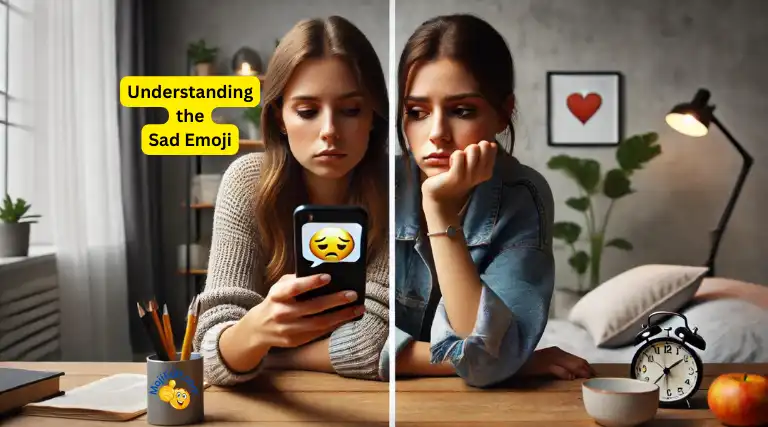O Emoji Triste 😢: Expressando empatia e dor
Introdução
Have you ever noticed how the sad emoji 😭—that tiny yellow face with a single tear—has become such a staple in our texts and posts? It’s not just about expressing sadness anymore. This little icon has grown into a powerful tool for conveying everything from disappointment to deep empathy, making it a key part of how we communicate online. But just how deep does its impact go? Let’s dive in and explore the layers of meaning behind the sad emoji, and why it’s so much more than just a frown in your chat.
Sad Emoji: Just a Frown in Your Chat or More?
You might think of the sad emoji as just a simple frown in your chat, but it’s actually so much more than that. This little yellow face carries a world of meaning and can be used in various contexts to communicate a range of emotions. For example, imagine your friend shares some disappointing news—maybe they didn’t get the job they were hoping for. Sending a sad emoji in response might seem small, but it actually conveys sympathy, understanding, and a shared sense of disappointment.
But the power of the sad emoji doesn’t stop there. In a group chat discussing a recent global tragedy, like the devastating earthquake in Turkey earlier this year, using the sad emoji can be a way to express collective grief and solidarity. It’s a subtle but powerful tool for showing that you care, even when words might not be enough.
The sad emoji isn’t just a visual cue; it’s a bridge that connects us emotionally, helping us share our feelings across digital spaces. Whether in personal messages or public posts, it allows us to articulate complex emotions in a way that’s both simple and universally understood.
Everyday Use and Relatable Examples
Let’s face it—life can be full of ups and downs, and the sad emoji 😢 is there to help us navigate those emotional lows. Picture this: you’re texting with a close friend about a recent breakup. You both know that words alone can’t capture the depth of the pain, so you send a sad emoji 😭 alongside your message. That tiny, tearful face does more than just communicate your sadness—it’s a symbol of shared grief, a digital hug that says, “I’m here for you.”
Or maybe you’re scrolling through your social media feed and see that a beloved celebrity has passed away. 😔 A simple comment with the sad emoji lets others know that you’re mourning too, without needing to say much more. It’s a way to connect over a shared sense of loss, even with people you’ve never met.
The sad emoji also finds its place in more serious contexts. 🌍 When reflecting on global events—like the ongoing refugee crisis or the impact of climate change—using the sad emoji can help express the gravity of the situation. It’s a small but powerful way to acknowledge the suffering in the world, whether in a personal message or a public post. In moments like these, the sad emoji serves as a bridge, connecting us through our shared humanity and making complex emotions easier to express.
Everyday Use and Relatable Examples
Let’s face it—life can be full of ups and downs, and the sad emoji 😢 is there to help us navigate those emotional lows. Picture this: you’re texting with a close friend about a recent breakup. You both know that words alone can’t capture the depth of the pain, so you send a sad emoji 😭 alongside your message. That tiny, tearful face does more than just communicate your sadness—it’s a symbol of shared grief, a digital hug that says, “I’m here for you.”
Or maybe you’re scrolling through your social media feed and see that a beloved celebrity has passed away. 😔 A simple comment with the sad emoji lets others know that you’re mourning too, without needing to say much more. It’s a way to connect over a shared sense of loss, even with people you’ve never met.
The sad emoji also finds its place in more serious contexts. 🌍 When reflecting on global events—like the ongoing refugee crisis or the impact of climate change—using the sad emoji can help express the gravity of the situation. It’s a small but powerful way to acknowledge the suffering in the world, whether in a personal message or a public post. In moments like these, the sad emoji serves as a bridge, connecting us through our shared humanity and making complex emotions easier to express.
Finding Balance in Emoji Use ⚖️
Like most things in life, using the sad emoji 😢 is all about balance. While it can be a powerful way to express and share emotions, it’s important to consider the context before hitting send. 🤔 Ask yourself: Does this situation truly call for a display of sadness, or might another emoji better capture how I’m feeling?
For instance, if you’re responding to a friend’s tough day at work, a sad emoji might be just the right touch. But if the conversation is more light-hearted, like sharing a funny meme, maybe a different emoji—like a laughing face 😂—would be a better fit. The key is to ensure that your message is clear and that the emoji you choose enhances, rather than confuses, the tone of your communication.
Another important aspect of balance is moderation. 😊 While it’s tempting to use the sad emoji frequently (because let’s face it, life has its moments), overusing it can lead to emotional fatigue for both you and the people you’re communicating with. To keep your messages effective, try to mix things up. Combine the sad emoji with thoughtful words, or even use it sparingly to give it more impact when you do use it. 📝
By being mindful of when and how you use the sad emoji, you can ensure that your digital interactions remain meaningful and supportive, without contributing to unnecessary negativity. 🌟
Best Practices for Using Sad Emojis 💡
To get the most out of the sad emoji 😢 while avoiding potential downsides, it’s important to follow a few best practices. These tips will help you ensure that your messages are clear, effective, and emotionally resonant.
1. Context is Key 🔑
Always consider the context when using the sad emoji. Is the situation serious or light-hearted? Is the conversation personal or public? The sad emoji can quietly express emotional nuances, conveying a sense of introspection and understated sorrow. For example, in a message to a friend who’s going through a tough time, the sad emoji might be just the right touch. But in a more casual setting, you might want to choose a different emoji to better fit the mood.
2. Moderation is Essential 🧘
Just like with any tool, moderation is key. Overusing the sad emoji can lead to emotional fatigue or even desensitization. If you find yourself reaching for the sad emoji too often, it might be a good idea to mix things up with other forms of expression. This not only keeps your communication fresh but also ensures that the sad emoji retains its impact when you really need it.
3. Complement with Words ✍️
While emojis are powerful, they’re often best used in combination with words. A well-placed sad emoji paired with a thoughtful message can provide clarity and additional support. For instance, instead of just sending 😢, you might say, “I’m so sorry to hear that 😢. I’m here if you need to talk.” This approach ensures that your message is both clear and empathetic.
4. Stay Genuine 💖
The sad emoji is a tool for genuine emotional expression, so use it authentically. It can be used with emojis de coração to share support and genuine emotions. Don’t feel pressured to use it just because others are doing so—only reach for it when it truly reflects how you feel. Authenticity in your digital communications helps build trust and stronger connections with those you interact with.
By following these best practices, you can make sure that your use of the sad emoji is thoughtful, effective, and supportive—helping to create more meaningful interactions online. 🌟
The Cultural Impact of the Sad Emoji 🌍
The sad emoji 😢 has become more than just a digital expression of sadness—it’s a symbol that often reflects the collective emotions of society, especially during major global events. For instance, during the COVID-19 pandemic, the sad emoji was everywhere. People used it to express grief over the rising number of cases, to mourn the loss of loved ones, and to show solidarity with those affected by the crisis. 😷 It became a universal way for people to connect over shared challenges and support one another emotionally, even from a distance.
Similarly, when influential public figures pass away, the sad emoji often surges in use. 😔 Whether it’s a beloved musician, an inspiring activist, or a legendary actor, the sad emoji becomes a digital candle, honoring the memory of those who’ve left a mark on the world. It’s a way for fans and followers to come together in mourning, creating a shared space for grief and remembrance.
Beyond just individual events, the sad emoji has also become a tool for expressing broader societal concerns. 🌎 From climate change and environmental disasters to social justice movements, the sad emoji allows people to convey their feelings about issues that affect us all. It’s a small but powerful way to acknowledge the pain and struggles of the world, and to show that we care.
In these ways, the sad emoji has evolved into more than just a simple icon—it’s a cultural touchstone that reflects our shared human experiences and emotions. 💔
Psychological Effects of Using Sad Emojis 🧠
The sad emoji 😢 isn’t just a digital tool—it can have real psychological effects on both the sender and the receiver. On the positive side, using the sad emoji can be a healthy way to express emotions that might be difficult to articulate with words alone. For many, it serves as a quick and easy way to communicate feelings of sadness, regret, or empathy. According to research, expressing emotions—even through something as simple as an emoji—can have physical and mental health benefits. 🧘♀️ By acknowledging and sharing your emotions, you might experience a sense of relief or connection, knowing that others understand and support you.
However, it’s important to be mindful of the potential downsides. 😔 Frequent exposure to sadness, even in emoji form, can affect your mood and overall emotional state. Some studies suggest that constantly engaging with negative content online, including sad emojis, might contribute to feelings of sadness, anxiety, or even depression. 😟 This is especially true if the sad emoji is used repeatedly in a short period, creating an environment that feels overwhelmingly negative.
To maintain a healthy balance, it’s crucial to be aware of how often you’re using or encountering sad emojis. 🧐 If you notice that they’re contributing to a more negative mood, it might be helpful to take a break or focus on more positive interactions. Remember, the goal is to express and process emotions, not to amplify them unnecessarily.
In short, while the sad emoji can be a valuable tool for emotional expression, it’s important to use it thoughtfully to avoid unintentionally impacting your or others’ mental well-being. 🌸
Sad Emojis in Online Communities 🌐
In the vast world of online communities, the sad emoji 😢 has become a key tool for expressing and navigating complex emotions. Whether you’re part of a support group, a discussion forum, or a social media community, the sad emoji helps members articulate their feelings without the need for lengthy explanations.
For example, in support groups for individuals dealing with chronic illness, the sad emoji is often used to acknowledge the challenges and hardships faced by others. 😔 It’s a way of saying, “I see you, and I understand,” without needing to spell out every detail. This simple gesture fosters a sense of solidarity and mutual support, reinforcing the community’s role as a safe space for empathy and connection.
Similarly, in online forums discussing global issues—like climate change or social justice—the sad emoji allows members to express their emotional reactions to news or events quickly. 🌍 When a new article is posted about the devastating effects of a natural disaster, a flood of sad emojis in the comments section shows a collective sense of grief and concern. It’s a way of coming together in shared sadness, even when the members of the community are scattered across the globe.
However, it’s important to be mindful of how frequently sad emojis are used in these spaces. 😢 While they can be powerful tools for expressing emotion, overuse can contribute to a more negative atmosphere, potentially making the community feel like a place of constant sorrow rather than one of balanced support.
In online communities, the sad emoji serves as both a shorthand for expressing difficult emotions and a way to build connections with others who understand. 🌟 But as with any tool, it’s most effective when used thoughtfully and in moderation.
Conclusion: The Power of the Sad Emoji 😢
In today’s digital world, the sad emoji 😭 is so much more than just a tiny tearful face. It’s a powerful tool for expressing and sharing emotions across a wide range of contexts—from personal chats with friends to global discussions about major events. Whether you’re offering support, expressing empathy, or reflecting on something sorrowful, the sad emoji helps you connect with others in a way that words alone often can’t.
But with great power comes great responsibility! ⚖️ It’s important to use the sad emoji thoughtfully, considering the context, the impact on others, and your own emotional well-being. By finding the right balance, you can ensure that your digital communications are clear, meaningful, and supportive.
So next time you’re reaching for that sad emoji, take a moment to reflect. Are you expressing genuine emotion? Is it the right tool for the situation? And most importantly, are you using it in a way that builds connections and understanding rather than amplifying negativity? 🌟
Remember, the sad emoji is a small but powerful symbol in our digital conversations—let’s use it wisely to create a more empathetic and connected online world. 😊
Perguntas e respostas frequentes
he sad emoji, often known as the crying face emoji, symbolizes feelings of sadness, disappointment, or grief. It’s commonly used to express sorrow or empathy in digital conversations.
Use the sad emoji when you want to convey sympathy, empathy, or personal sadness in response to emotional distress, unhappy events, or when offering condolences. It’s a quick way to show that you care.
Yes, there are several variations, including the “crying face” 😢, “loudly crying face” 😭, and “pensive face” 😔. Each represents different levels of sadness or introspection, allowing for nuanced emotional expression.
Alternatives include expressing sadness through words, using other emojis like the broken heart 💔 or pensive face 😔, or combining emojis with text to provide a clearer emotional message.
Yes, overusing the sad emoji can diminish its impact and might lead to misunderstandings or convey excessive negativity. It’s important to use it thoughtfully and contextually.




